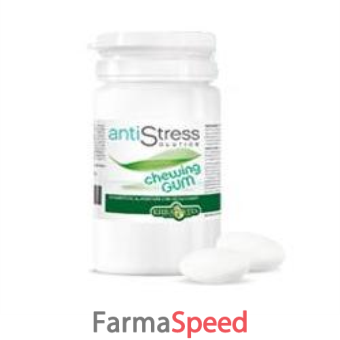antiStress
chewing
GUM
Complemento alimentare utile per il rilassamento in caso di stress, a base di camomilla, lavanda, biancospino e tiglio con edulcoranti.
Indicato come coadiuvante in situazioni di stress.
Non apporta sonnolenza, è pratico e gustoso.
Camomilla e Biancospino Donano un'azione positiva sul benessere mentale.
Lavanda e Tiglio Dall'azione rilassante.
Ingredienti Camomilla; lavanda; biancospino; tiglio.
Modalità d'uso2-4 chewing-gum durante la giornata, da masticare per 15-20 minuti, per favorire un miglior assorbimento.
Avvertenze Non superare la dose giornaliera raccomandata.
Tenere fuori dalla portata dei bambini al di sotto dei 3 anni di età.
Gli integratori non vanno intesi come sostituti di una dieta variata.
Per donne in gravidanza o in allattamento e bambini si raccomanda di sentire il parere del medico.
Formato Flacone da 16 chewing-gum.
Bibliografia - Selye H. Studies on adaptation. Endocrinology 1937;21:169.
- Selye H. Stress. Acta Inc. Montreal: Med. Publ. 1950.
- Brekhman II, Dardymov IV. New substances of plant origin which increase nonspecific resistance. Annu Rev Pharmacol 1969;9:419-30.
- Dardymov IV, Kashina E. The effect of Ginseng and Eleutherococcus glycosides on hexokinase activity. Lek. Sredstva Dal’nego Vostoka (Remedies of the Far East), The Institute of Biologically Active Substance of the USSR, Akademy of Science, Vladivostok Russia, 1972;2:56-9.
- Lupandin AV. The role of catecholaminergic synapses in the mechanism of adaptation formation under the action of polyphenolic adaptogens, Fiziol Zh SSSR Im I M Sechenova. 1989;75(8):1082-8.
- Panossian A, Wikman G, Wagner H. Plant adaptogens III. Earlier and more recent aspects and concepts on their mode of action. Phytomedicine 1999;6(4):287-300.
- Peng WH, Hsieh MT, Lee YS, Lin YC, Liao J; Anxiolytic effect of seed of Ziziphus jujuba in mouse models of anxiety. J. Ethnophatmacol, 72(3): 435-41, 2000.
- Han BH, Park MH, Park JH, Chemical and pharmacological studies on sedative cyclopeptide alkaloids in some Rhamnaceae plants. Pure App. Chem, 61:443-8, 1989.
9) Devi S., Pandey VB et al. Peptide alkakoids from Zizyphus spp. Phytochemistry, 26(12):3374-3375, 1987.
- Juneja LR, Chu DC, Okubo T, Nagato Y, Yokogoshi H. L-theanine: a unique amino acid of green tea and its relaxation effect in humans. Trends in Food Science & Technology, 10, 199-204, 1999.
- Kucinskaite A, Briedis V, Savickas A., Experimental analysis of therapeutic properties of Rhodiola rosea L. and its possible application in medicine. Medicina (Kaunas). 2004;40(7):614-9.
- Tolonen A, Pakonen M, Hohtola A, Jalonen J. Phenylpropanoid glycosides from Rhodiola rosea Chem Pharm Bull (Tokyo). 2003 Apr;51(4):467-70.
- Gaffney BT, Hugel HM, Rich PA. Panax ginseng and Eleutherococcus senticosus may exaggerate an already existing biphasic response to stress via inhibition of enzymes which limit the binding of stress hormones to their receptors. Med Hypotheses. 2001 May;56(5):567-72.
- Davydov M, Krikorian AD. Eleutherococcus senticosus (Rupr. & Maxim.) Maxim. (Araliaceae) as an adaptogen: a closer look. J Ethnopharmacol. 2000 Oct;72(3):345-93.
- Lecouvey, M.; Frochot, C.; Miclo, L.; Orlewski, P.; Driou, A.; Linden, G.; Gaillard, J.-L.; Marraud, M.; Cung, M. T. and Vanderesse, R. (1997). Two-dimensionnal H-NMR and CD structural analysis in a micellar medium of a bovine a s1-casein fragment having benzodiazepine-like properties. Eur. J. Biochem. 248, 872-878.
- Miclo, L.; Perrin, E.; Driou, A.; Papadopoulos, V.; Boujrad, N.; Vanderesse, R.; Boudier,J.-F.; Desor, D.; Linden, G. and Gaillard J.-L. (June 8, 2001). Characterization of a-casozepine, a tryptic peptide from bovine a s1-casein with benzodiazepine-like activity. The FASEB Journal express article 10.1096/fj.00-0685fje. Published online.
- Lanoir, D.; Canini, F.; Messaoudi, M.; Lefranc, C.; Demagny, B.; Martin, S. and Bourdon, L. (2002). Long term effects of a bovine milk alpha-S1 casein hydrolysate on healthy low and high stress responders. Stress, 5 (suppl.), 124.
- Messaoudi, M.; Bresson, J.-L.; Desor, D.; Lefranc, C.; Boudier, J.-F. and Paquin, P. (2002). Anxiolytic-like effects of the milk protein hydrolysate Prodiet F200 in healthy human volunteers. Stress, 5 (suppl.), 124.
- Schroeder, H.; Violle, N.; Messaoudi, M.; Lefranc-Millot, C.; Nejdi, A.; Demagny, B.;Desor, D. (2003). Effects of ING-911, a tryptic hydrolysate from bovine milk aS1-casein on anxiety of Wistar male rats measured in the conditioned defensive burying paradigm and the elevated plus maze test. Behavioural Pharmacology, 14 (S1), S38, P31.
NOTA BENE: le informazioni presenti nelle schede prodotto che potrete consultare in questo sito non devono essere interpretate come consulenza medica e non intendono, né possono sostituire le prescrizioni mediche.
Le immagini, se presenti, sono fornite al solo scopo illustrativo e non costituiscono elemento identificativo.



